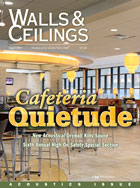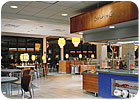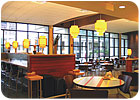
When Berkshire Dining Commons, a bustling student dining hall at the University of Massachusetts-Amherst, came up for renovation, the school polled students for suggestions on how to improve their dining experience.
Though the 26,500 square-foot, 800-seat facility had already been rated as the best college cafeteria by the National Association of College & University Food Services in 2005, student responses indicated that Berkshire Dining Commons could not rest on its laurels. Students wanted new food stations offering a larger variety of options, such as Pan Asian and vegetarian/vegan cuisine, brick-oven-baked pizzas and an on-site bakeshop. In addition to these requests, they addressed two major issues affecting the dining experience -poor lighting and excessive noise.
UMass-Amherst Dining Services hired Waltham, Mass., architectural firm Livermore & Edwards to address these problems. After studying the facility’s original interior, the architects decided that they could alleviate the lighting and noise problems with a more strategically designed acoustic ceiling system. The original drab honeycomb ceiling did little to help spread natural light throughout the large room or curb the spread of conversation and kitchen noise.

Sun and Sound
“The sunlight wasn’t traveling much farther than the windows, and there were plenty of dark areas inside the building,” said Robert Livermore, president of Livermore & Edwards. “Then, there was a real acoustics problem around the dining area. With 800 seats, hard floors and everybody talking at once, you could hardly hear what the person across from you was saying. So, it was very important to have a ceiling that both reflected and spread natural light throughout the building, while also absorbing all of that excess noise.”Livermore researched acoustic ceiling products and specified CertainTeed Ecophon Focus DG ceiling tiles for the project. They are made from high-density glass wool, providing the needed sound absorption, and feature a bright white finish for optimum light reflection. The fact that the tiles are washable was also an important factor, as the same ceiling tiles would be used over the food service area of the facility
“I don’t think we’ve ever come across a ceiling product as nice as this one,” he added.
The focal point of Livermore & Edwards’ design called for a creative, semi-concealed grid, floating ceiling with wings that curve back 50 degrees near the facility’s windows. This creates both an attractive appearance and a reflector of natural sunlight, which then spreads throughout the rest of the building. The new exposed ceiling design also allows better sound absorption.
“We liked the fact that we were able to hang the ceiling tiles between the existing concrete beams so we could leave the beams exposed and display them in the ceiling,” Livermore said. “With exposed ceilings, sound waves get up behind the ceiling panels for better sound absorption and acoustic control.”
However, taking a design that looks great on paper and transforming it into a finished product that’s both visually appealing and functional often involves a good amount of teamwork between architect and contractors.
In April 2006, following a complete interior gutting of the cafeteria, interior contractor N.T. Oliva, Inc., of East Hartford, Conn., was ready to begin the ceiling installation. To ensure a smooth installation and an excellent finished product, Consigli Contracting and N.T. Oliva worked on-site with Livermore. To make the ceiling system work, though, a few modifications had to be made to the original design plans in the early stages of the project.
“Right from the start, we encountered some coordination issues that we had to work through,” said Sean Ditto, Project Manager for Consigli Contracting. “We had to lower the ceiling a bit and there was a fair amount of coordination involved with the light fixtures.”
With the collaboration between the three parties, though, these obstacles were soon overcome.
“The architect had some unique ideas for the ceiling design, and he was very flexible and cooperative with us in the effort to accomplish the look he wanted,” said Nick Oliva, president of N.T. Oliva, Inc.

The biggest challenge
Though other parts of the building had a more standard ceiling design, the arched ceiling of the dining area presented the biggest challenge. The crew hung curved metal trim and modified it to conform to the architect’s specs. One of the bigger challenges was connecting the rest of the ceiling with the wing pieces and curved trim near the windows.Oliva explained, “Once the grid was up, though, installing the panels was a pretty smooth process. The grid was segmented to the curve, so the panels went in as they would in a standard installation. It created a nice effect.”
To streamline the installation, the crew had on-site assistance from CertainTeed Ceilings Technical Project Coordinator, Anthony Antonelli.
“CertainTeed’s technical support rep gave us some great hands-on coaching and was extremely helpful,” Oliva said. “Not only did he know how to work out the problems we were having, but he also knew how to jump in and swing a hammer! We had the right crew for the job and the right people working alongside of us.”
N.T. Oliva installed 7,000 square feet of tile, finishing in August 2006. The new Berkshire Dining Commons opened in September 2006 and has since received rave reviews from students and faculty. The larger variety of food options and stunning new interior design has definitely drawn more hungry customers from all over the University of Massachusetts campus, said Don DuCharme, facilities manager.
“We’ve probably doubled or tripled the number of students coming in to dine on a daily basis,” he says. “We’re serving between 6,000 and 7,500 students a day now. It’s a very popular place.”
